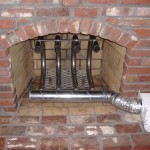Fireplace With Glass Rocks: Aesthetics, Functionality, and Considerations
Fireplaces have evolved from purely functional heating sources to central design elements in contemporary homes. Among the numerous options for fireplace aesthetics, glass rocks have emerged as a popular and visually striking alternative to traditional logs. This article explores the features, benefits, and essential considerations relevant to fireplaces that incorporate glass rocks.
Glass rocks, also known as fire glass or fire pit glass, are tempered glass pieces designed to withstand the high temperatures of a fireplace. They are available in various shapes, sizes, and colors, offering homeowners considerable flexibility in customizing the look of their fireplace. Unlike wood logs, glass rocks do not produce ash, soot, or smoke, contributing to a cleaner burning experience and reduced maintenance requirements. The reflective surfaces of the glass create a mesmerizing display of light and dancing flames, adding visual interest and a modern touch to any living space.
Aesthetic Advantages of Glass Rocks
The primary appeal of glass rocks lies in their aesthetic versatility. The wide array of colors allows homeowners to match the glass to their existing décor or create a bold statement piece. From vibrant blues and greens reminiscent of ocean depths to subtle ambers and grays that evoke a sense of natural warmth, the options are virtually limitless. The different shapes and sizes further contribute to the ability to personalize the fireplace's appearance. Smooth, rounded pebbles offer a softer, more organic look, while angular, shard-like pieces create a more dramatic, contemporary effect.
Furthermore, the reflective properties of glass rocks significantly enhance the visual impact of the flames. The light from the fire bounces off the glass surfaces, amplifying the glow and creating a dynamic interplay of light and shadow. This effect is particularly pronounced in darker rooms, where the glass rocks can effectively brighten the space and create a cozy ambiance. The reflective quality also contributes to the illusion of a larger fire, making it an ideal choice for smaller fireplaces.
Beyond color and shape, the arrangement of the glass rocks plays a crucial role in the overall aesthetic. Some homeowners prefer a uniform, evenly distributed layer of glass, while others opt for a more randomized, textured look. The strategic placement of larger pieces can create focal points and add depth to the display. Experimentation is encouraged to achieve the desired aesthetic. It is important to ensure that the burner ports are not fully obstructed, as this can impact the flame pattern and efficiency of the fireplace.
Functional Benefits and Considerations
Beyond aesthetics, glass rocks offer several functional advantages over traditional wood-burning fireplaces. The most significant benefit is the cleaner burning experience. Since glass is non-combustible, it does not produce ash, soot, or smoke. This eliminates the need for frequent cleaning and reduces the risk of respiratory irritation. Furthermore, fireplaces with glass rocks typically require less ventilation than wood-burning fireplaces, as there is no need to exhaust smoke and combustion byproducts.
However, certain functional aspects require careful consideration. Glass rocks do not radiate heat in the same way as wood logs. While they do absorb and reflect heat, they do not retain it for an extended period. This means that fireplaces with glass rocks may not be as effective for providing sustained warmth. The primary purpose often shifts towards aesthetics and ambiance. The BTU output of the fireplace, determined by the burner and gas supply, remains the primary factor in heat generation.
Proper installation and maintenance are crucial for ensuring optimal performance and longevity. The fireplace must be designed or retrofitted to accommodate glass rocks. This typically involves using a burner specifically designed for use with glass media. The burner should be sized appropriately for the fireplace and capable of delivering a consistent and even flame. Regular cleaning is also necessary to remove dust and debris that can accumulate on the glass surfaces. While glass rocks are durable, they can become chipped or cracked over time, particularly if exposed to excessive heat or impact. Replacing damaged glass is essential to maintain the aesthetic appeal and prevent potential safety hazards.
Safety and Installation Guidelines
Safety is paramount when dealing with any type of fireplace, and those utilizing glass rocks are no exception. It is imperative to use tempered glass specifically designed for fireplace use. Standard glass will shatter or even explode when exposed to high temperatures, creating a dangerous situation. Ensure the glass rocks are sourced from a reputable manufacturer that adheres to industry safety standards.
Professional installation is highly recommended, especially when converting an existing fireplace to use glass rocks. A qualified technician can assess the fireplace's compatibility, install the appropriate burner, and ensure that all gas connections are secure. Improper installation can lead to gas leaks, carbon monoxide poisoning, and other serious hazards. If attempting a DIY installation, meticulously follow the manufacturer's instructions and adhere to all applicable building codes and safety regulations. It is always advisable to consult with a professional if there are any doubts or uncertainties.
Ventilation is another critical safety consideration. While glass rocks do not produce smoke, the fireplace still consumes oxygen during combustion. Adequate ventilation is necessary to prevent carbon monoxide buildup. Ensure that the room is properly ventilated, especially when using the fireplace for extended periods. A carbon monoxide detector should be installed in the vicinity of the fireplace as an additional safety measure. Regular testing of the detector is essential to ensure its proper functioning.
Furthermore, it is crucial to keep flammable materials away from the fireplace. While glass rocks themselves are non-combustible, surrounding furniture, curtains, and other objects can pose a fire hazard if placed too close to the flames. Maintain a safe distance between the fireplace and any potentially flammable items. Supervision is necessary when children or pets are present to prevent accidental contact with the hot glass surfaces.
Choosing the right type of burner is also critical for safety and performance. There are two primary types of burners used with glass rocks: H-burners and linear burners. H-burners are typically used in smaller fireplaces and provide a more concentrated flame pattern. Linear burners are designed for larger fireplaces and create a wider, more evenly distributed flame. The choice of burner depends on the size and shape of the fireplace, as well as the desired aesthetic. Ensure the burner is compatible with the type of gas being used, whether natural gas or propane. Using the wrong type of burner can result in inefficient combustion and potentially dangerous conditions.

We Will Be Updating Our Fireplace To Use Glass Rocks Rather Than Logs Outdoor Gas Firepit That Fire

Fire Pit Glass Everything You Need To Know

25 Fireplace Decorating Ideas With Gas Logs Electric And Glass Rocks

Self Install Fireplace Glass

Fireplace Doors

Gallery Of Converted Natural Gas Fireglass Fireplaces And Outdoor Fire Pits Glass Fireplace

Mua Gaspro 10 Lbs Fire Glass For Propane Pit 1 2 Inch Reflective Fireplace Rocks Table Cobalt Blue Trên Mỹ Chính Hãng 2024 Giaonhan247

Element Fire Glass 1 2 Cobalt Blue Reflective 10lbs Com

Fire Pit Glass Everything You Need To Know

Lava Rock Vs Fire Glass Blog Fireplace And Chimney Authority








